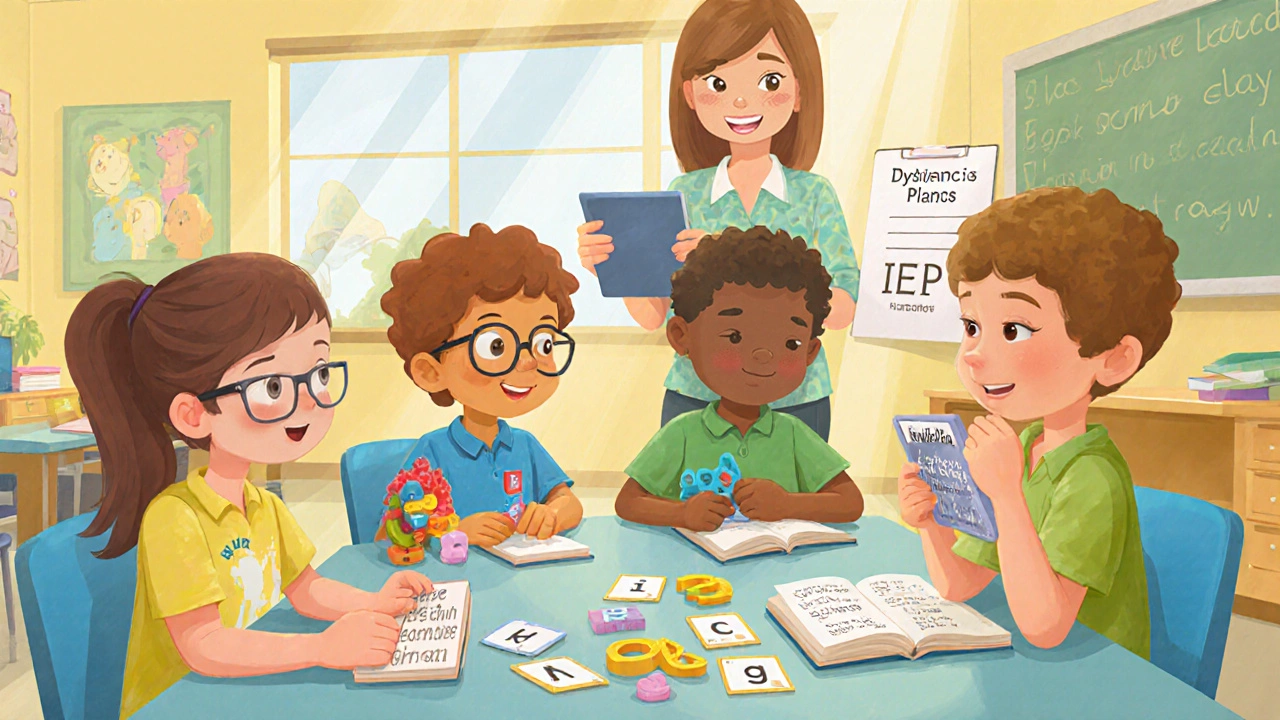Learning Disability Improvement Tracker
Select a Learning Disability
Compare typical age ranges for improvement and key support strategies for common learning disabilities
Learning Disability Improvement Tracker
Typical Age Range for Improvement:
Key Factors Supporting Progress:
Strategies to Support Improvement
Quick Takeaways
- Most learning disabilities don’t fully disappear but many improve significantly after school years.
- Typical age ranges for noticeable progress: dyslexia (10‑14), ADHD (12‑16), ASD‑related learning challenges (14‑18).
- Early intervention, tailored instruction, and supportive environments are the biggest levers.
- Regular cognitive assessments help track change and adjust strategies.
- If difficulties persist beyond late teens, consider adult‑focused services and accommodations.
Parents and educators often wonder if there’s a magic age when learning disabilities simply vanish. The short answer: they rarely disappear outright, but many young people experience marked improvement as the brain matures and as targeted supports take effect. Below we break down what research and real‑world experience tell us about age‑related trends, the factors that shape them, and what you can do to boost progress at every stage.
What Exactly Is a Learning Disability?
Learning disability is a neurologically based disorder that affects the brain’s ability to receive, process, store, or produce information. It can involve reading, writing, math, or broader executive‑function skills, and it usually shows up in school‑age children. The termcovers a range of specific conditions, each with its own profile.
Common Types and Their Typical Age Trajectories
While each child’s path is unique, clinicians have observed general patterns for the most prevalent conditions.
| Condition | Typical Onset | Age When Noticeable Improvement Often Occurs | Key Factors Supporting Progress |
|---|---|---|---|
| Dyslexia | 5‑7 years | 10‑14 years | Phonics‑based instruction, multisensory tutoring, increased reading volume |
| ADHD | 3‑5 years | 12‑16 years | Behavioral therapy, medication when appropriate, structured routines |
| Autism Spectrum Disorder (ASD)‑related learning challenges | Early childhood | 14‑18 years | Social‑communication interventions, visual supports, executive‑function coaching |
| Specific Learning Disorder - Math (Dyscalculia) | 6‑8 years | 11‑15 years | Concrete manipulatives, step‑by‑step problem solving, frequent practice |
| Language Processing Disorder | 4‑6 years | 9‑13 years | Speech‑language therapy, auditory discrimination games, vocabulary building |
Why Do Some Kids Show Improvement as They Grow Older?
The brain remains plastic well into the twenties. Two scientific concepts help explain the age‑related shifts:
- Neuroplasticity - the brain’s ability to reorganize neural pathways in response to experience and training.
- Executive function development - higher‑order skills like planning, attention control, and working memory mature significantly during adolescence.
When children receive systematic, evidence‑based instruction during these windows, the underlying neural circuitry can strengthen, leading to better performance on reading, math, or attention tasks.
Key Factors That Influence Whether a Disability Improves or Persists
- Early Intervention: Programs that begin before age8, such as Early Intervention services, show the highest gains.
- Quality of Instruction: Structured, explicit teaching (e.g., Orton‑Gillingham for dyslexia) beats generic classroom help.
- Family Involvement: Consistent practice at home, reading together, or using assistive tech reinforces school‑based gains.
- IEP or 504 Plans: A well‑crafted Individualized Education Program (IEP) ensures accommodations (extra time, audio books) are legally guaranteed.
- Co‑existing Conditions: ADHD, anxiety, or sensory processing issues can mask improvement in core academic skills.
- Socio‑economic Context: Access to tutoring, technology, and stable housing correlates with better outcomes.
How to Support Your Child at Different Ages
Below is a practical roadmap you can follow as your child moves from early childhood into adulthood.
- Preschool (3‑5): Focus on language exposure, play‑based motor skills, and early speech‑language therapy if signs appear.
- Early Elementary (6‑9): Implement a solid Individualized Education Program (IEP) or 504 plan. Use multisensory reading programs, visual math tools, and short, frequent breaks.
- Mid‑Elementary (10‑12): Shift toward self‑advocacy. Teach organizational strategies (checklists, color‑coded folders) and introduce assistive tech (text‑to‑speech, audio note‑taking).
- Middle School (13‑15): Emphasize executive‑function coaching. Encourage participation in study groups and provide opportunities for “strength‑based” projects (art, coding, sports) that boost confidence.
- High School (16‑18): Prepare for transition to higher education or work. Conduct a thorough Cognitive assessment to document remaining challenges, then negotiate accommodations with colleges or employers.
- Adulthood (19+): Seek adult disability services, job‑coach support, and lifelong learning opportunities. Many adults benefit from continued tutoring in specific areas, such as business math or technical writing.
Common Myths About Learning Disabilities “Disappearing”
Myth #1: “If a child reads well by high school, the disability is gone.”
Reality: The brain may have compensated, but underlying processing speed differences often remain, affecting fast‑paced environments like college exams.
Myth #2: “Medication cures ADHD‑related learning issues.”
Reality: Medication can improve attention, but without strategic instruction the academic gap stays.
Myth #3: “All learning disabilities fade after puberty.”
Reality: Some individuals continue to need accommodations well into their 30s, especially for reading speed and working‑memory challenges.

When to Seek Professional Help
If your child:
- Shows a plateau in reading or math scores despite consistent instruction.
- Struggles with organization, time‑management, or executive function beyond typical teenage turbulence.
- Experiences low self‑esteem or anxiety linked to academic tasks.
Contact a licensed educational psychologist for a cognitive assessment. The results will guide whether an updated IEP, new therapeutic approach, or different accommodations are needed.
Bottom Line
Learning disabilities seldom vanish like a magic trick at a certain birthday. What does happen is a blend of brain development, high‑quality support, and lived experience that often leads to substantial gains-especially during the pre‑teen and teen years. By staying proactive, using evidence‑based interventions, and monitoring progress with regular assessments, you give your child the best shot at thriving at every age.
Frequently Asked Questions
Do learning disabilities ever completely disappear?
Most do not vanish entirely, but many individuals develop coping strategies and see measurable improvement in academic performance as they age.
At what age is dyslexia most likely to improve?
Significant gains are often observed between ages 10 and 14, especially when students receive structured phonics instruction and regular reading practice.
Can ADHD medication eliminate learning difficulties?
Medication can improve attention, but without targeted teaching methods and organizational supports, academic challenges usually persist.
How often should a child with a learning disability be reassessed?
A good rule is every 2‑3years, or sooner if there’s a noticeable change in performance, a transition to a new school level, or new co‑occurring issues.
What are the best tools for teens with lingering reading difficulties?
Text‑to‑speech software, audiobooks, dyslexia‑friendly fonts (e.g., OpenDyslexic), and spell‑check extensions that highlight errors without interrupting flow.
